
Catocala fulminea, the yellow bands underwing, is a moth of the family Erebidae. The species was first described by Giovanni Antonio Scopoli in his 1763 Entomologia Carniolica. It is found in central and southern Europe, east Asia and Siberia. The xarippe lineage has been proposed to be a distinct and valid species in its own right, instead of being only subspecifically distinct.

Catocala piatrix, the penitent underwing, is a moth from North America. The species was first described by Augustus Radcliffe Grote in 1864. It is placed in subfamily Catocalinae, either of the family Noctuidae, or – if the Noctuidae are circumscribed more strictly – of family Erebidae. Within the Catocalinae, it belongs to tribe Catocalini and – if the Noctuidae are circumscribed widely – subtribe Catocalina.

Catocala meskei, or Meske's underwing, is a moth of the family Erebidae. The species was first described by Augustus Radcliffe Grote in 1873. It is found in North America from Maine and Quebec west to southern Alberta and Montana, south to South Carolina in the east and at least Montana in the west.
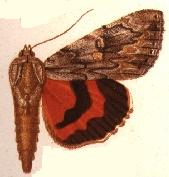
Catocala coccinata, the scarlet underwing, is a moth of the family Erebidae. The species was first described by Augustus Radcliffe Grote in 1872. It is found in southern Canada and the eastern United States, following river valleys onto the Great Plains and down to Florida.

Catocala junctura, the joined underwing or Stretch's underwing, is a moth in the family Erebidae. The species was first described by Francis Walker in 1858. It is found throughout temperate North America, ranging from New York and Pennsylvania west to Montana, Colorado, Oklahoma, Arizona, and into Texas, and north to southern Illinois, extreme southern Alberta and Saskatchewan; it has also been recorded west of the Rocky Mountains from California and south-eastern British Columbia. It is typically found near water, where the food plants of its caterpillar larvae grow plentifully.
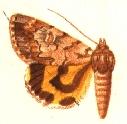
Catocala praeclara, the praeclara underwing, is a moth of the family Erebidae. The species was first described by Augustus Radcliffe Grote and Coleman Townsend Robinson in 1866. It is found in North America from Nova Scotia west to south-eastern Alberta, south to Florida and Kansas.
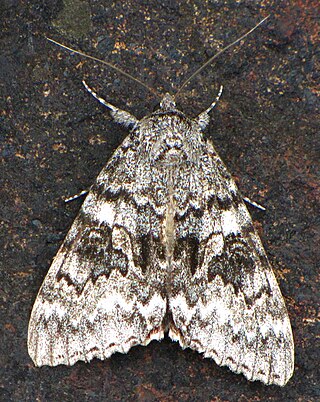
Catocala semirelicta, the semirelict underwing, is a moth of the family Erebidae. The species was first described by Augustus Radcliffe Grote in 1874. It is found in North America from Nevada, Colorado, Utah, California, and Nova Scotia south to Maine, west across Canada to British Columbia, and southward in the mountains.

Catocala ultronia, the dark red underwing or ultronia underwing, is a moth of the family Erebidae. The species was first described by Jacob Hübner in 1823. It is found in most of eastern North America, south to Florida and Texas. It ranges west across the southern parts of Canada to extreme southeast British Columbia.
Catocala hymenaea is a moth of the family Erebidae first described by Michael Denis and Ignaz Schiffermüller in 1775. It is found from the Middle East to western Asia.
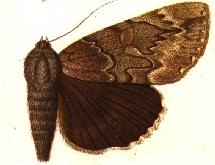
Catocala residua, the residua underwing, is a moth of the family Erebidae. The species was first described by Augustus Radcliffe Grote in 1874. It is found in North America from southern Ontario, Quebec and Maine south to North Carolina and Georgia west to Mississippi and Missouri and north to Iowa, Illinois and Michigan.

Catocala badia, the bay underwing, bayberry underwing or old maid, is a moth of the family Erebidae. It is found from southern Maine and New Hampshire south to New York and Connecticut.
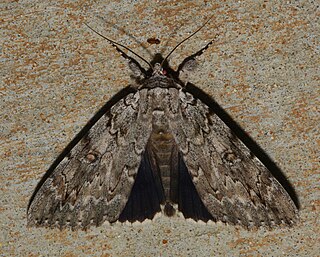
Catocala robinsonii, or Robinson's underwing, is a moth of the family Erebidae. The species was first described by Augustus Radcliffe Grote in 1872. It is found in North America from southern Ontario and New Hampshire south to Florida west to Oklahoma, Missouri and Arkansas and northward to Illinois, Indiana, and Michigan.

Catocala subnata, the youthful underwing, is a moth of the family Erebidae. The species was first described by Augustus Radcliffe Grote in 1864. It is found in North America from Manitoba, Ontario, Quebec, and New Brunswick to Nova Scotia, south through Maine and Connecticut to North Carolina and west to Tennessee, Kentucky, and Texas, then north to Iowa, Wisconsin, and Michigan.
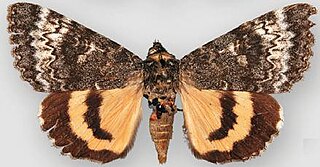
Catocala grotiana, or Grote's underwing, is a moth of the family Erebidae. The species was first described by James S. Bailey in 1879. It is found in the US from Arizona, north through Utah into Colorado. It has also been spotted in Washington and in the western US north and east of California.

Catocala verrilliana, or Verrill's underwing, is a moth of the family Erebidae. The species was first described by Augustus Radcliffe Grote in 1875. It is found in the US from Washington and Oregon to Colorado and south to California, Arizona and Texas, and Cimarron County in western Oklahoma.

Catocala alabamae, the Alabama underwing or titan underwing, is a moth of the family Erebidae. It is found from Pennsylvania south to Florida, west to Texas and north to Missouri, Wisconsin, and Illinois.

Catocala grynea, the woody underwing, is a moth of the family Erebidae. The species was first described by Pieter Cramer in 1780. It is found in North America from Ontario and Quebec through Maine and Connecticut, south to Florida, west to Texas and north through Iowa to Wisconsin and Minnesota.
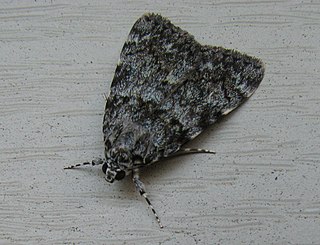
Catocala lineella, the lineella underwing, little lined underwing or steely underwing, is a moth of the family Erebidae. The species was first described by Augustus Radcliffe Grote in 1872. It is found in North America from Ontario and Quebec south to Florida west to Texas and north to Ohio.

Catocala mira, the wonderful underwing, is a moth of the family Erebidae. The species was first described by Augustus Radcliffe Grote in 1876. It is found in North America from Manitoba through southern Ontario and Quebec through New Hampshire and Connecticut to Florida, west to Texas and north through Iowa and Illinois.

Catocala sordida, the sordid underwing, is a moth of the family Erebidae. The species was first described by Augustus Radcliffe Grote in 1877. It is found in North America from Saskatchewan east to New Brunswick and Prince Edward Island and south through Maine and Connecticut to Florida, west to Texas and north to Manitoba.












